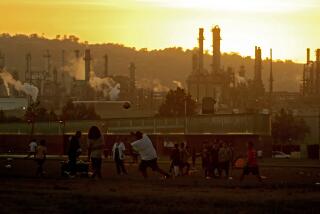CalPERS panel OKs broader mix
- Share via
SACRAMENTO — The California Public Employees’ Retirement System, the nation’s largest government pension fund, Monday moved to diversify its portfolio by buying commodities, such as oil and timberlands, and by investing in public-private partnerships that build roads, bridges, airports and other projects.
Although still heavily invested in stocks and bonds, the investment committee overseeing the $260-billion fund -- commonly known as CalPERS -- voted 9 to 3 to shift about $28 billion over three years to the so-called alternative investments. The strategy is expected to be ratified Wednesday by the CalPERS board of directors.
“This is a hedge against inflation,” said state Treasurer Bill Lockyer, a Democrat. He is a CalPERS board member who serves on the investment committee and voted for the new strategy. He called the change “a periodic, midcourse correction that’s absolutely necessary to stay on a path that guarantees we’ll keep our promises to retirees and won’t overcharge taxpayers.”
Many nonprofit foundations and universities in recent years have begun similar broadening of their portfolios to reap better returns on their money and to build up their endowments.
The move also comes at a time when the nation’s economy is flirting with a downturn, bonds are producing modest yields and stock values are fluctuating wildly from day to day. As a result, the pressure grows on CalPERS to produce an annual return of at least 7.75%.
The state says it needs to make that much to pay for retirement and healthcare benefits for about 1.5 million local and state government workers and their families, without asking for help from a strapped state treasury.
To keep meeting that earnings threshold, CalPERS Chief Investment Officer Russell Read wants to hold a wider range of investments that would put more money into a new class of investments known as Inflation-Linked Assets.
“We see the commodities program as part of a larger important investment in natural resources,” Read said in an interview after the vote. Energy sources, such as oil, natural gas and electricity, will be a key component of CalPERS’ future investments, he said.
Partnering with governments and private investors to build ports, railroads and water treatment plants would be “ a win-win situation” for CalPERS members, local and municipal governments and for economic development spurred by developing new facilities, Read said.
The new mix of assets includes outright ownership of commodities and trading in commodities futures.
The change in the massive fund, now at about $260.7 billion, would reduce fixed-income bond investments to 19%, down from the current 26%.
Holdings of both U.S. and foreign publicly traded stocks would decline to 56% from 60%, worth $10.2 billion based on current fund values, according to documents presented to investment committee members.
The move to the new mix would be phased in over three years.
CalPERS’ change in strategy makes sense in terms of diversifying its portfolio, spreading risk and boosting returns, said Michael Rosen, the principal at Angeles Investment Advisors, a Los Angeles-based pension fund advisor. “CalPERS historically has been a leader in the pension community in moving into alternative strategies, and they have done so very successfully,” he said.
The new CalPERS strategy isn’t a drastic departure.
The fund has been moving gradually toward alternative investments, including real estate, since the 1980s, said Steve Nesbitt, chief executive of Cliffwater. The Marina del Rey consulting firm advises many university endowments and nonprofit organizations on their portfolios. “The move into real assets is a reason why endowments have done well, investing in oil and gas partnerships and timber,” he said.
In moving to a broader-based portfolio with less reliance on stocks and bonds, CalPERS is pushing for a more diversified portfolio than the smaller state pension plan, the California State Teachers’ Retirement System.
CalSTRS, the nation’s second-largest public fund with $174 billion in assets, currently has no investments in commodities and is in the early stages of considering putting money into large projects like airports or other brick-and mortar projects, spokesman Ricardo Duran said.
More to Read
Inside the business of entertainment
The Wide Shot brings you news, analysis and insights on everything from streaming wars to production — and what it all means for the future.
You may occasionally receive promotional content from the Los Angeles Times.











